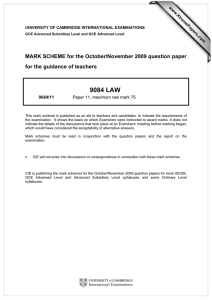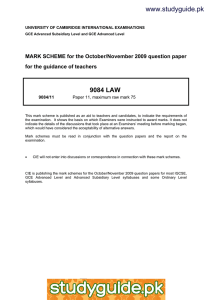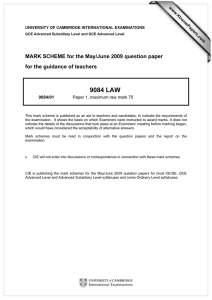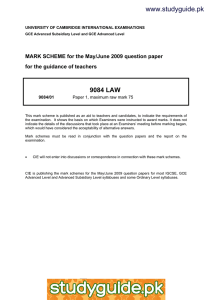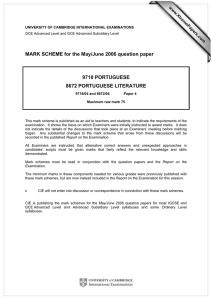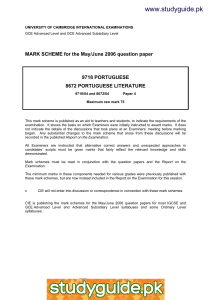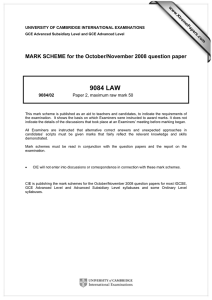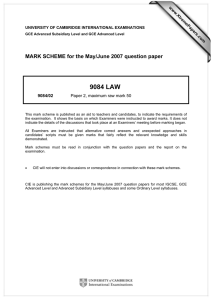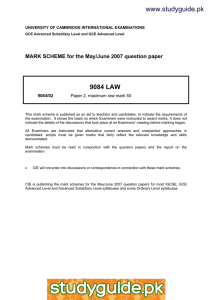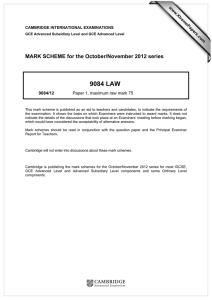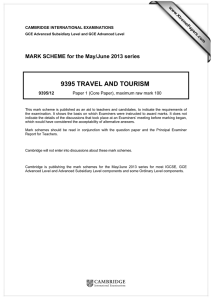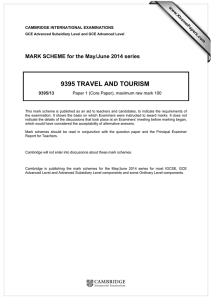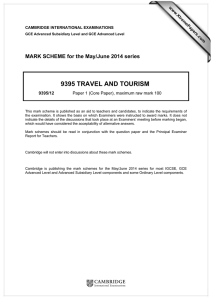9084 LAW MARK SCHEME for the October/November 2011 question paper
advertisement
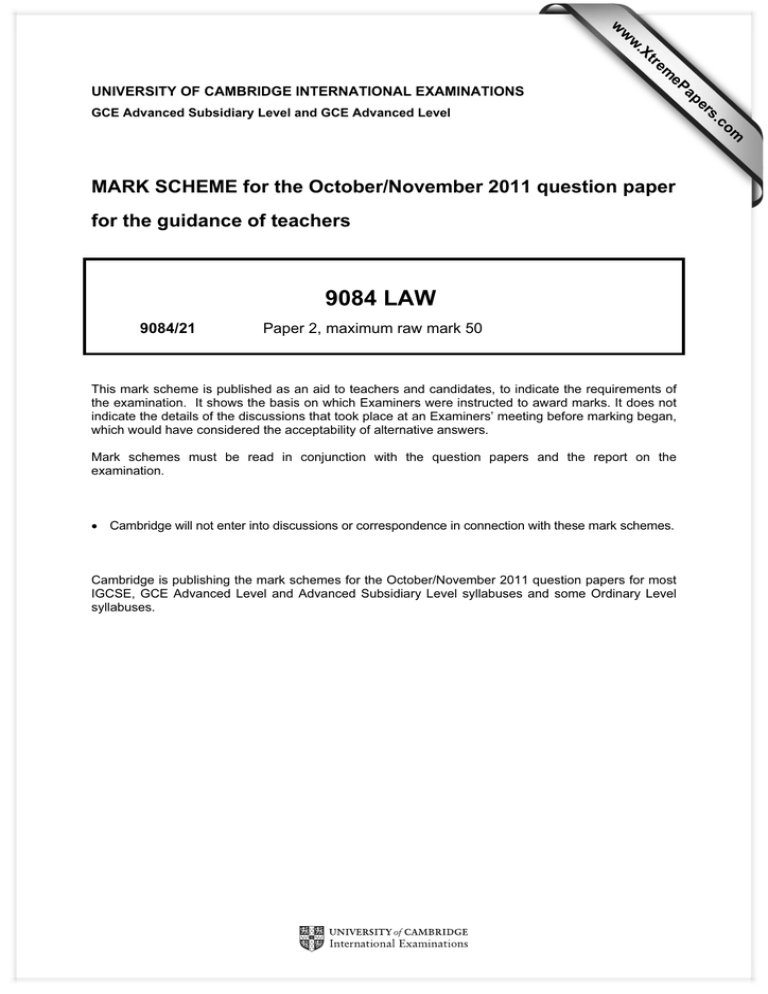
w w ap eP m e tr .X w UNIVERSITY OF CAMBRIDGE INTERNATIONAL EXAMINATIONS for the guidance of teachers 9084 LAW 9084/21 Paper 2, maximum raw mark 50 This mark scheme is published as an aid to teachers and candidates, to indicate the requirements of the examination. It shows the basis on which Examiners were instructed to award marks. It does not indicate the details of the discussions that took place at an Examiners’ meeting before marking began, which would have considered the acceptability of alternative answers. Mark schemes must be read in conjunction with the question papers and the report on the examination. • Cambridge will not enter into discussions or correspondence in connection with these mark schemes. Cambridge is publishing the mark schemes for the October/November 2011 question papers for most IGCSE, GCE Advanced Level and Advanced Subsidiary Level syllabuses and some Ordinary Level syllabuses. om .c MARK SCHEME for the October/November 2011 question paper s er GCE Advanced Subsidiary Level and GCE Advanced Level Page 2 Mark Scheme: Teachers’ version GCE AS/A LEVEL – October/November 2011 Syllabus 9084 Paper 21 General Marking Guidance This mark scheme includes a summary of appropriate content for answering each question. It should be emphasised, however, that this material is for illustrative purposes and is not intended to provide a definitive guide to acceptable answers. It is quite possible that among the scripts there will be some candidate answers that are not covered directly by the content of this mark scheme. In such cases, professional judgement should be exercised in assessing the merits of the answer and the senior examiners should be consulted if further guidance is required. Mark Bands The mark bands and descriptors applicable to all questions on the paper are as follows. Indicative content for each of the questions follows overleaf. Band 1: The answer contains no relevant material. Band 2: The candidate introduces fragments of information or unexplained examples from which no coherent explanation or analysis can emerge OR The candidate attempts to introduce an explanation and/or analysis but it is so fundamentally undermined by error and confusion that it remains substantially incoherent. Band 3: The candidate begins to indicate some capacity for explanation and analysis by introducing some of the issues, but explanations are limited and superficial OR The candidate adopts an approach in which there is concentration on explanation in terms of facts presented rather than through the development and explanation of legal principles and rules OR The candidate attempts to introduce material across the range of potential content, but it is weak or confused so that no real explanation or conclusion emerges. Band 4: Where there is more than one issue, the candidate demonstrates a clear understanding of one of the main issues of the question, giving explanations and using illustrations so that a full and detailed picture is presented of this issue OR The candidate presents a more limited explanation of all parts of the answer, but there is some lack of detail or superficiality in respect of either or both so that the answer is not fully rounded. Band 5: The candidate presents a detailed explanation and discussion of all areas of relevant law and, while there may be some minor inaccuracies and/or imbalance, a coherent explanation emerges. © University of Cambridge International Examinations 2011 Page 3 1 Mark Scheme: Teachers’ version GCE AS/A LEVEL – October/November 2011 Syllabus 9084 Paper 21 (a) Hari would have very little chance of success in his claim. Hunter v Canary Wharf suggests that there is no cause of action for interference with television reception. Candidates must discuss the case in some detail to reach maximum marks. (b) Hari would have very little chance of success if he brings an action based on his lack of a view. Aldred’s case suggests that there is no cause of action for a landowner based on the lack of a view. For MAX marks candidates should also refer to the judgement of Lord Justice Pill in Hunter v Canary Wharf. (c) The doctrine of precedent means that certain courts are bound by previous decisions in a higher court. The Court of Appeal will bind the High Court. There are ways that a claimant can avoid a previous decision of the Court of Appeal, principally if the judge distinguishes the facts of the case. (d) There are many advantages of adopting precedent in law. The main advantages are of course predictability and the possible saving of time and costs because the chances of success are better predicted. The better candidates will see the problems of precedent and say that the advantages are limited because principles cannot develop and rely on an overburdened legislature. For max marks candidates must reach a conclusion. 2 (a) Kray may be guilty of an offence under ss 18 and 19 Firearms Act 1968 as he has a shotgun in his car and it may be close enough to the robbery. See R v Pawlicki and Swindell. Candidates must discuss the issue in Pawlicki, namely that it is a question of accessibility to the guns which is really at issue in any case. (b) Briggs may have committed an offence under s.19(b) Firearms Act 1968 as he is found with an air rifle under his jacket. Under the Act, an offence is committed whether it is loaded or not. (c) Brian has committed an offence under s.19(d) Firearms Act 1968 because he has an imitation firearm; candidates should discuss s.57(4) for definition of an imitation firearm. (d) The Police and Criminal Evidence Act (PACE) 1984 introduced a number of provisions, including right to have legal advice, right to have someone informed of the arrest, an appropriate adult when the dependant has a disability, right to have a phone call. There are strict limits on how long a person can be detained without charge, although these can be extended in some cases, such as prevention of terrorism. There are also rules about the manner of questioning. A general discussion about PACE will carry some credit but MAX 10 marks. © University of Cambridge International Examinations 2011
